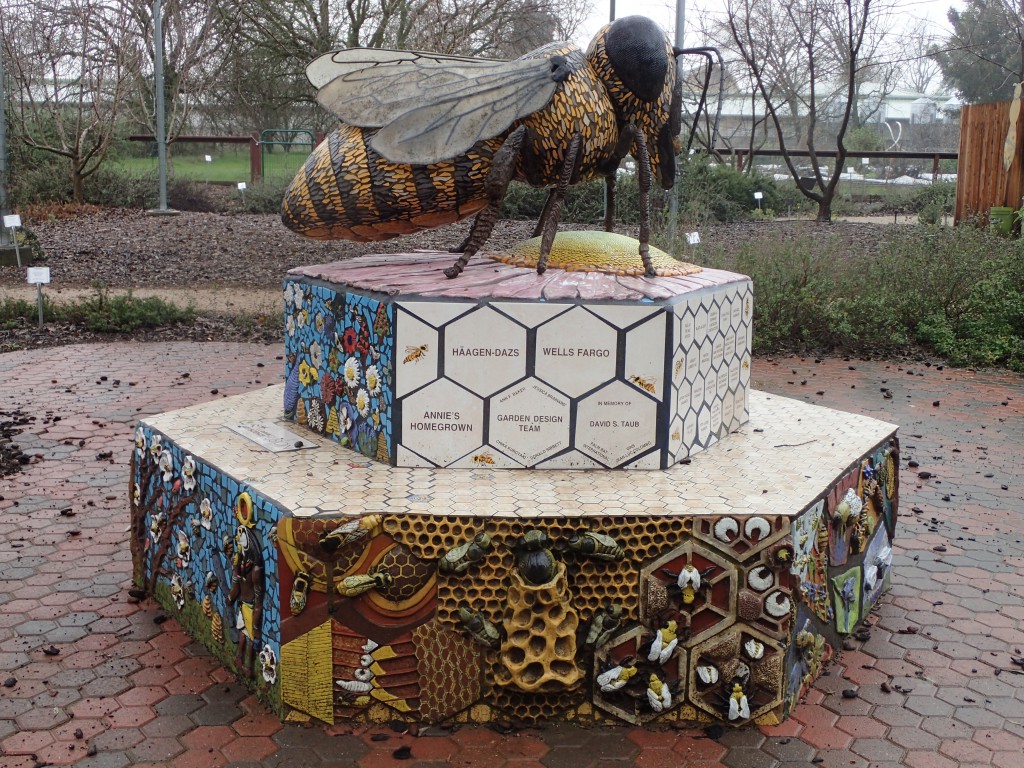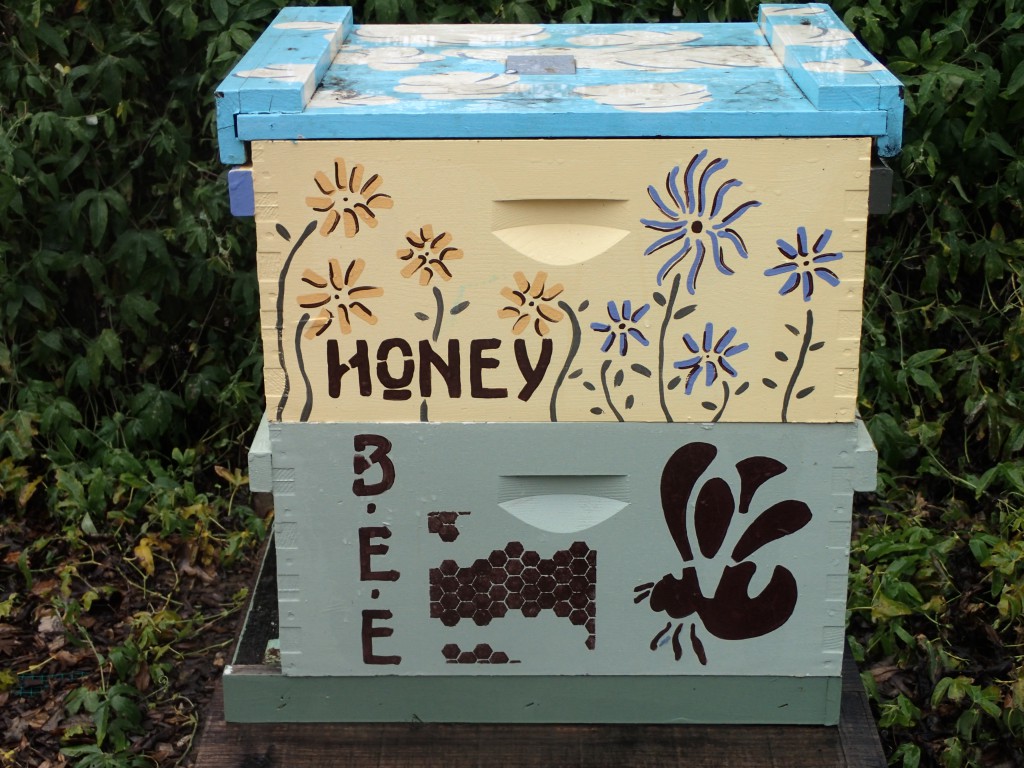On a dreary day in mid-winter I stopped by the Häagen-Dazs Honey Bee Haven, which is operated by my alma mater, UC Davis. I first visited the garden shortly after it opened to the public in 2009, when all the plants were babies. Even then it supported an astonishing array of honey bees and native pollinators, and now that the plants have grown up and the gardeners continue to make improvements, it will be indeed be what its name says, a haven for insects, wildlife, and people.
I love the sign that greets people as they enter the garden. It is hexagonal, of course, and has information or art on all six sides. It’s a bench and an art piece, and an educational exhibit, all rolled into one.
Given that it is the dead of winter and raining a bit, there was zero insect activity. But I do kind of like gardens in the winter, especially after the solstice when the days are getting longer and plants start working on their spring buds. There’s a feeling of spring around the corner even if it’s drizzly and gloomy today. Plus, mid-winter is when honey bee colonies begin growing again. The bees will be out foraging any time it’s not raining or too windy, and the queen will resume her egg-laying duties. This also the time of year when managed colonies are most likely to starve–if a beekeeper has taken too much honey, or hasn’t right-sized the hives so that honey stores are near the clusters of overwintering bees, they may run out of food just at the time that there are more mouths to feed.
The spring nectar flow is when honey bee colonies grow, and thus are likely to throw swarms. Just as egg-laying is the way that new bees are produced, swarming is the way that new colonies are produced. A responsible beekeeper takes measures to reduce the number of swarms thrown by her managed colonies, for a couple of good reasons: (1) bees lost when a swarm is thrown are bees that could have been used to start another managed hive; and (2) swarms often end up in undesirable locations, such as a neighbor’s tree or house. A large part of being a good backyard beekeeper is keeping the neighbors happy. Gifts of honey are helpful, of course, but proper care to reduce swarms is just as essential.
Even with the most diligent care, some swarms are going to happen. While it’s fun to go catch a swarm, there’s also something satisfying about catching a swarm from one’s own hive. The Honey Bee Haven beekeepers have put up a bait hive in a tree outside the garden proper:
The idea behind a bait hive is exactly what it sounds like. If a colony swarms, the beekeeper hopes that the bees will be attracted to the bait hive and decide to move in. A bait hive is usually a miniature hive box containing a few frames of drawn-out wax and maybe some honey. Hopefully the scout bees in the swarm will like the familiar scents of wax and honey, and convince their sisters that the bait hive will be the ideal home. It’s a nice strategy, but doesn’t always work.
I hadn’t been to the Honey Bee Haven for a couple of years, and was happy to see that they now have established a bee hive right in the garden. And it’s a pretty hive, too.
Judging from the condition of the paint this hive is a relatively recent addition to the garden. I watched the entrance for a while, but given the weather conditions the bees were all sensibly tucked up inside the hive.
Of course, you can’t just put a bee hive in a garden visited by the public, even if the garden’s raison d’être is to be a haven for bees, without proper signage to inform said public. Besides, maybe the visitors don’t know what a bee hive looks like, and are wondering what those boxes are all about.

I really like that people can come to the garden and observe the activities of an actual bee hive. And I imagine that the beekeepers have populated this hive with what I call sweet bees; that is, a queen whose genetics produce mellow bees that aren’t likely to take offense at visitors who are watching from a safe distance (in this case, about 2.5 meters). The door to this hive faces to the left in the photo above, so the bees’ flight path will take them safely away from visitors.
The last time I visited the Haven it was summer, in the midst of a prolonged drought. One of very cool things I saw was a watering platform for bees. Bees do drink water, and they also take water back to the hive to dilute honey, reliquify honey that has crystallized in the comb, and for evaporative cooling when it’s hot. The Haven provides water for bees, without threat of drowning, on these nifty slabs:
The slab slopes a bit so that water drains off the end and doesn’t pool. Right now the taps are closed, and given all the recent rain it’s easy for bees to find water, but in the summer one of taps will be opened enough so that the tiniest trickle of water drips onto the stone and accumulates in the little troughs. Bees can land on the stone and drink.
The Haven was designed and built to accommodate not just honey bees, but all sorts of animal pollinators. The planners included these “bee condos” to provide nesting areas for carpenter bees:

16 January 2016
© Allison J. Gong
Carpenter bees don’t eat wood, but they chew into it to make burrows for their larvae. They can be a nuisance, as to them the rafters or eaves of a human’s house often make prime real estate for bee burrows. Providing them an attractive site to deposit their eggs might draw them away from human structures. Carpenter bees are large, shiny, black bees, easily distinguished from the fuzzy bumble bees, and as California native pollinators should not be regarded as pests. Watching them buzz through the garden like heavy air-borne tanks is one of the joys of spring. I think this year I’ll put up a carpenter bee condo of my own and see if I can get them to nest in it. Fortunately, the Haven provides instructions for a DIY bee condo! If you’ve ever wondered how you can protect native pollinators, this is something that’s easy to do.





